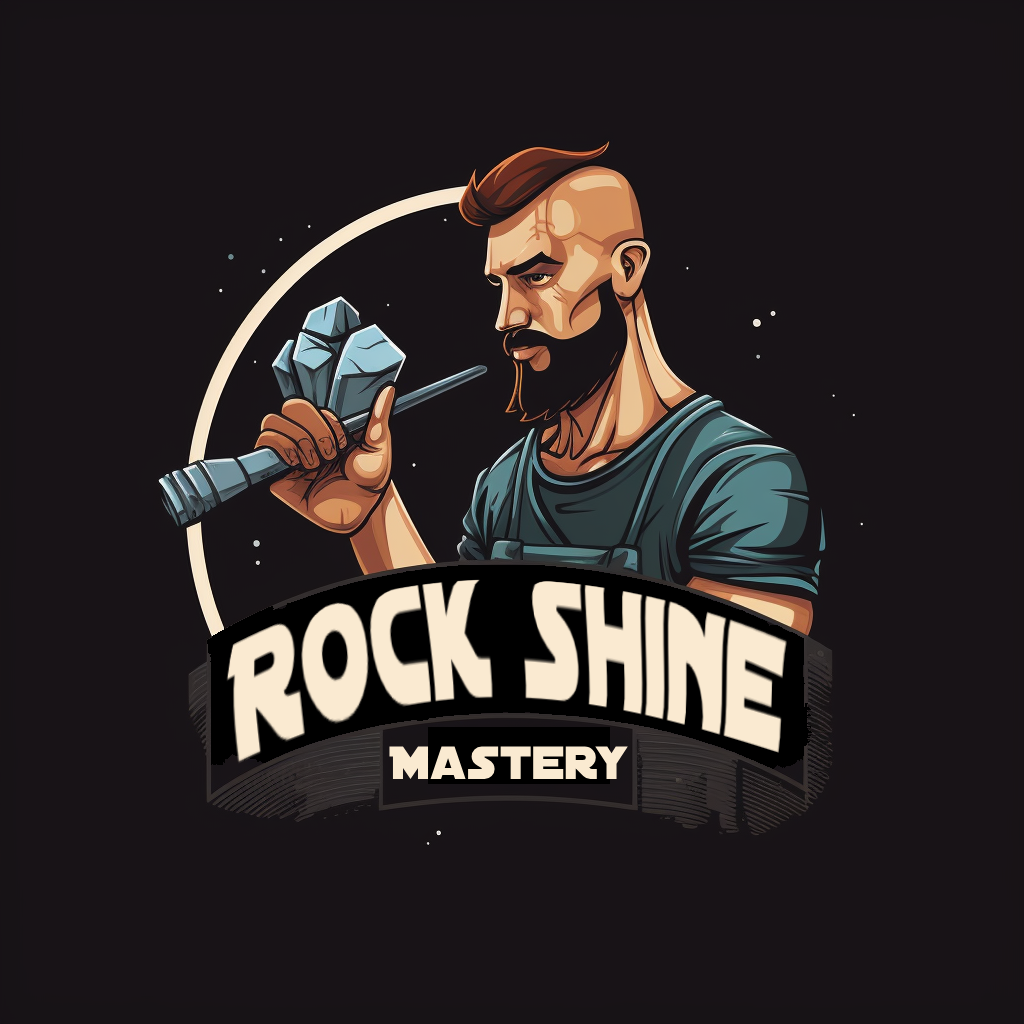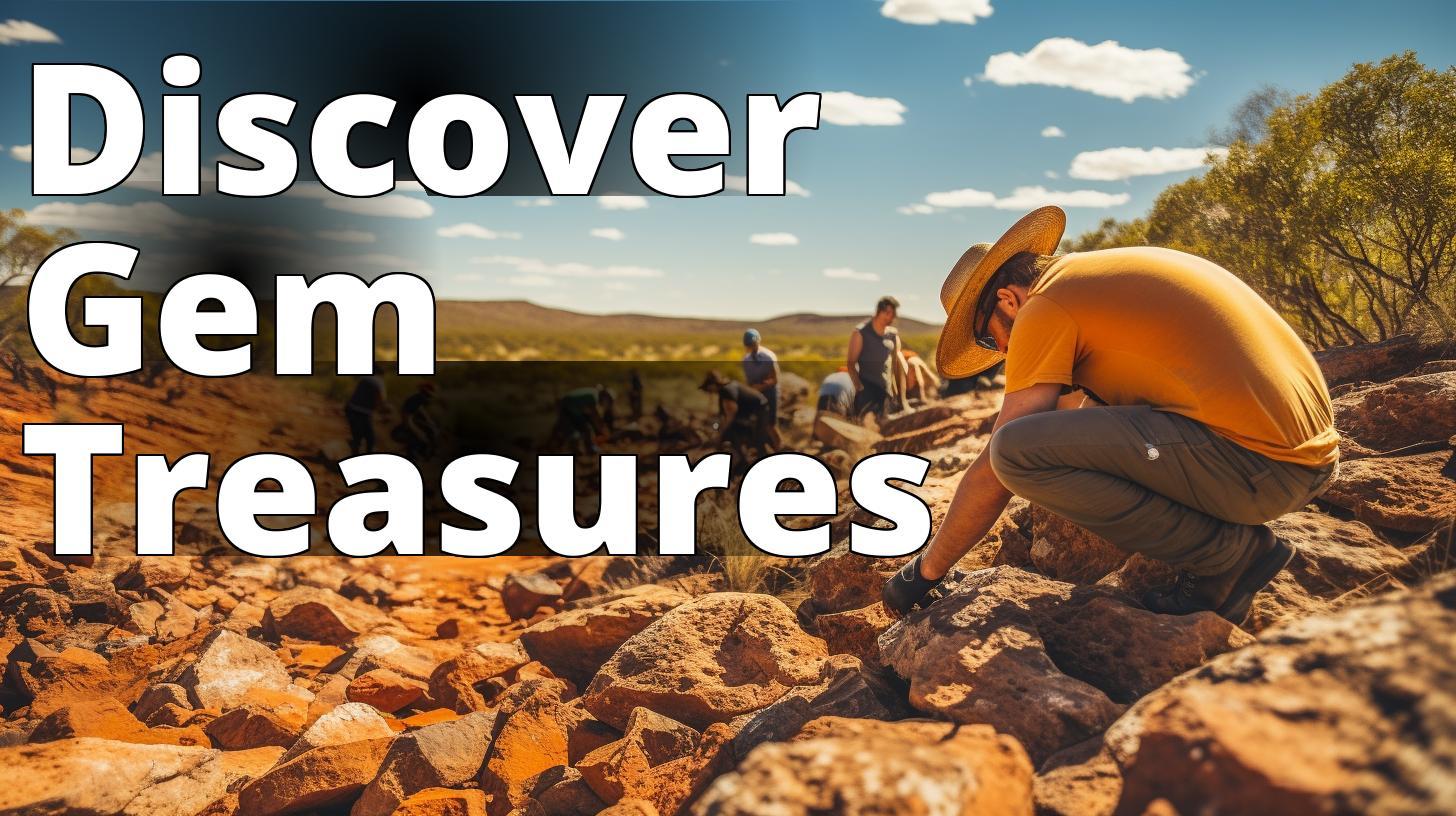Are you a rock polishing and lapidary hobbyist between the ages of 30 and 60? If so, you’re in for a treat! Australia is home to some of the world’s most renowned fossicking sites, where you can search for precious gemstones, minerals, and fossils while exploring the country’s remote and beautiful locations. In this guide, we will explore the top fossicking and rockhounding locations in Australia, provide personal accounts and experiences, discuss necessary tools and equipment, cover ethics and conservation, and offer tips and techniques for lapidary and rock polishing.

Top Fossicking and Rockhounding Locations in Australia
| Location | Description | Link |
|---|---|---|
| Killiecrankie, Tasmania | Known for its topaz, smoky quartz, and fluorite deposits. Accessible only by boat or a long hike. | Australian Geographic |
| Harts Range, Northern Territory | Famous for its garnet deposits, this location also offers zircon, topaz, and quartz. Accessible by car, with nearby camping facilities. | Australian Geographic |
| Lightning Ridge, New South Wales | The go-to destination for opals, especially the sought-after black opals. The town has several opal mines, shops, and facilities for visitors. | We Are Explorers |
| Gemfields, Queensland | The largest sapphire field in the southern hemisphere, offering a variety of sapphire types and colors. The area has mines, accommodation, and equipment hire for visitors. | Australian Geographic |
| Agate Creek, Queensland | Known for its colorful and uniquely designed agates. Accessible by car, with nearby camping facilities. | Rock & Gem Magazine |
| Inverell, New South Wales | Famous for its sapphires, as well as zircon, topaz, and quartz. The area has mines, accommodation, and equipment hire for visitors. | N/A |
| Lune River, Tasmania | Home to sapphires, topaz, zircon, and quartz. Accessible by car, with nearby camping facilities. | N/A |
| Torrington, New South Wales | Known for its topaz, quartz, and garnet. Accessible by car, with nearby camping facilities. | N/A |
| Woodsreef, New South Wales | Famous for its fluorite, as well as topaz, zircon, and quartz. Accessible by car, with nearby camping facilities. | N/A |
| Opalton, Queensland | Renowned for its opals, as well as topaz and quartz. The area has mines, accommodation, and equipment hire for visitors. | Australian Geographic |
Australia boasts diverse landscapes, each with its unique geology and mineral deposits. Here are the top 10 fossicking and rockhounding locations in Australia, recommended by Australian Geographic:
- Killiecrankie, Tasmania: Explore this remote location known for its topaz, smoky quartz, and fluorite deposits. Accessible only by boat or a long hike, it rewards visitors with stunning scenery and the chance to find rare gemstones.
Link: Australian Geographic
- Harts Range, Northern Territory: Famous for its garnet deposits, this location also offers zircon, topaz, and quartz. Accessible by car, with nearby camping facilities.
Link: Australian Geographic
- Lightning Ridge, New South Wales: The go-to destination for opals, especially the sought-after black opals. The town has several opal mines, shops, and facilities for visitors.
Link: We Are Explorers
- Gemfields, Queensland: The largest sapphire field in the southern hemisphere, offering a variety of sapphire types and colors. The area has mines, accommodation, and equipment hire for visitors.
Link: Australian Geographic
- Agate Creek, Queensland: Known for its colorful and uniquely designed agates. Accessible by car, with nearby camping facilities.
Link: Rock & Gem Magazine
- Inverell, New South Wales: Famous for its sapphires, as well as zircon, topaz, and quartz. The area has mines, accommodation, and equipment hire for visitors.
- Lune River, Tasmania: Home to sapphires, topaz, zircon, and quartz. Accessible by car, with nearby camping facilities.
- Torrington, New South Wales: Known for its topaz, quartz, and garnet. Accessible by car, with nearby camping facilities.
Woodsreef, New South Wales: Famous for its fluorite, as well as topaz, zircon, and quartz. Accessible by car, with nearby camping facilities.
- Opalton, Queensland: Renowned for its opals, as well as topaz and quartz. The area has mines, accommodation, and equipment hire for visitors.
Link: Australian Geographic
When planning a trip to any of these locations, be sure to research the necessary permits and regulations, as well as accommodation options and equipment hire. Many of these areas are remote and require careful planning and preparation.
Summary
- The article covers an overview of fossicking and rockhounding in Australia, including the importance of responsible practices.
- It lists the top 10 fossicking and rockhounding locations in Australia, along with the types of gemstones and minerals that can be found in each location.
- The article also provides information on tools and equipment, ethics and conservation, personal accounts and experiences, as well as tips and techniques for lapidary and rock polishing.

Personal Accounts and Experiences of Fossicking and Rockhounding in Australia
Fossicking and rockhounding are popular hobbies in Australia, with many enthusiasts sharing their experiences and tips online. Here are some personal accounts and experiences:
- According to a recent article by Australian Geographic, Killiecrankie in Tasmania is a top destination for finding topaz, while Harts Range in the Northern Territory is known for its garnets.
- In a post on Reddit, an Earth Science student in SE Queensland seeks advice on finding interesting rocks beyond milky quartz or greywacke. They also seek recommendations for useful tools for fossicking.
- In an article for Rock & Gem Magazine, a writer shares their experience of fossicking for agates in Agate Creek, Queensland. They recommend bringing containers for collecting and considering the weight of the rocks being taken home.
- In a New York Times article, the growing popularity of crystal mining is discussed, along with concerns about the ethical and environmental implications.
These personal accounts provide valuable insights and tips for those interested in fossicking and rockhounding in Australia.
Personal Story: A Memorable Fossicking Adventure in Lightning Ridge
One of the most memorable experiences I had while fossicking in Australia was in the famous Lightning Ridge. This small town in New South Wales is renowned for its opal mining and is a must-visit destination for rockhounds and gem enthusiasts.
I arrived in Lightning Ridge with my trusty rock pick, shovel, and a sense of excitement. As I explored the opal fields, I couldn’t help but be amazed by the vibrant colors and shimmering beauty of the opals hidden beneath the surface. The thrill of uncovering these precious gemstones with my own hands was indescribable.
During my time in Lightning Ridge, I met a local miner named Jack who graciously shared his knowledge and expertise with me. He showed me the best areas to search for opals and taught me how to identify the different types and qualities of these gemstones. With his guidance, I was able to find a stunning black opal, which remains one of my most prized possessions.
Beyond the thrill of finding opals, what struck me during my time in Lightning Ridge was the sense of community among the fossickers and miners. There was a camaraderie and shared passion for gemstones that created a welcoming and inclusive atmosphere. I made friends with fellow enthusiasts from all walks of life, and we bonded over our love for fossicking and the treasures we unearthed.
My time in Lightning Ridge taught me the importance of responsible fossicking and respecting the land. I witnessed firsthand the impact that irresponsible mining practices can have on the environment and the local community. It reinforced my commitment to leaving no trace and following the local regulations to preserve these precious resources for future generations.
If you’re looking for an unforgettable fossicking adventure, I highly recommend visiting Lightning Ridge. Whether you’re a novice or an experienced rockhound, the opal fields of this unique town will captivate you with their beauty and the thrill of unearthing these rare gemstones.

Tools and Equipment for Fossicking and Rockhounding
Fossicking and rockhounding require specific tools and equipment for success. Here are the necessary tools and equipment:
Hand tools:
- Rock hammer: Chip away at rocks to reveal the minerals inside.
- Chisel: Control the process of chipping away at rocks.
- Pick: Break up hard rock.
- Shovel: Dig up soil and rocks.
- Sieve: Separate larger rocks from smaller ones.
Safety gear:
- Safety glasses: Protect your eyes from flying debris.
- Gloves: Shield your hands from sharp rocks and other hazards.
- Sturdy boots: Provide foot protection and grip on uneven terrain.
- Sunscreen: Guard your skin from harmful rays.
Optional equipment:
- Metal detector: Help locate buried treasures.
- Sluice box: Separate gold from other minerals.
- High banker: Process more material at once, an advanced version of a sluice box.
When purchasing tools and equipment, look for high-quality, durable products that will last. Read reviews and ask for recommendations from other fossickers and rockhounds.

Ethics and Conservation in Fossicking and Rockhounding
Fossicking and rockhounding can impact the environment and local communities. Follow ethical and conservation guidelines to minimize this impact. Here are tips for responsible fossicking and rockhounding:
- Leave no trace: Pack out all rubbish and leave the area as you found it.
- Respect local regulations: Be aware of any restrictions or regulations in the area.
- Stay on designated tracks: Avoid damaging vegetation and wildlife by sticking to designated tracks.
- Do not trespass: Always seek permission from landowners before entering private property.
- Do not damage rocks or minerals: Only collect what you need and leave the rest for others.
- Support local communities: Buy from local businesses and respect the rights of local communities.
By following these guidelines, you can help preserve Australia’s natural beauty and ensure that fossicking and rockhounding can be enjoyed by future generations.

Tools and Materials for Lapidary and Rock Polishing
Lapidary and rock polishing involve cutting, shaping, and polishing rocks and minerals to create beautiful jewelry and decorative objects. Here are the necessary tools and materials:
Cutting and shaping tools:
- Trim saw: Cut rough rocks into smaller pieces.
- Cabbing machine: Shape and polish rocks into cabochons, flat-backed gems used in jewelry-making.
- Diamond saw blades: Cut through hard rock and minerals.
Polishing tools:
- Tumbler: Polish rocks and minerals to a smooth finish.
- Polishing pads: Polish cabochons and other rocks.
- Diamond polishing compounds: Achieve a high gloss on rocks and minerals.
Safety gear:
- Safety glasses: Protect your eyes from flying debris.
- Dust mask: Protect your lungs from dust and debris.
- Gloves: Shield your hands from sharp rocks and other hazards.
Optional equipment:
- Faceting machine: Cut and polish faceted gems.
- Dremel tool: A versatile tool for various lapidary tasks.
When purchasing tools and materials, look for high-quality, durable products that will last. Read reviews and ask for recommendations from other lapidarists and rock polishers.
Tips and Techniques for L
Answers To Common Questions
Q: What is fossicking and rockhounding?
A: Fossicking and rockhounding involve searching for and collecting rocks, minerals, and gemstones.
Q: Who can go fossicking and rockhounding in Australia?
A: Anyone can participate in fossicking and rockhounding activities in Australia, regardless of age or experience.
Q: How can I find the best rockhounding locations in Australia?
A: Research online, join local rockhounding clubs, or consult guidebooks to discover the top rockhounding spots.
Q: What equipment do I need for fossicking and rockhounding?
A: You’ll need tools like a pick, shovel, sieve, and a storage bag to collect and carry your findings.
Q: How can I identify the rocks and minerals I find?
A: Utilize field guides, online resources, or seek assistance from experienced rockhounding enthusiasts.
Q: But what if I don’t have any experience in rockhounding?
A: No worries! There are plenty of beginner-friendly locations and resources available to help you get started.

